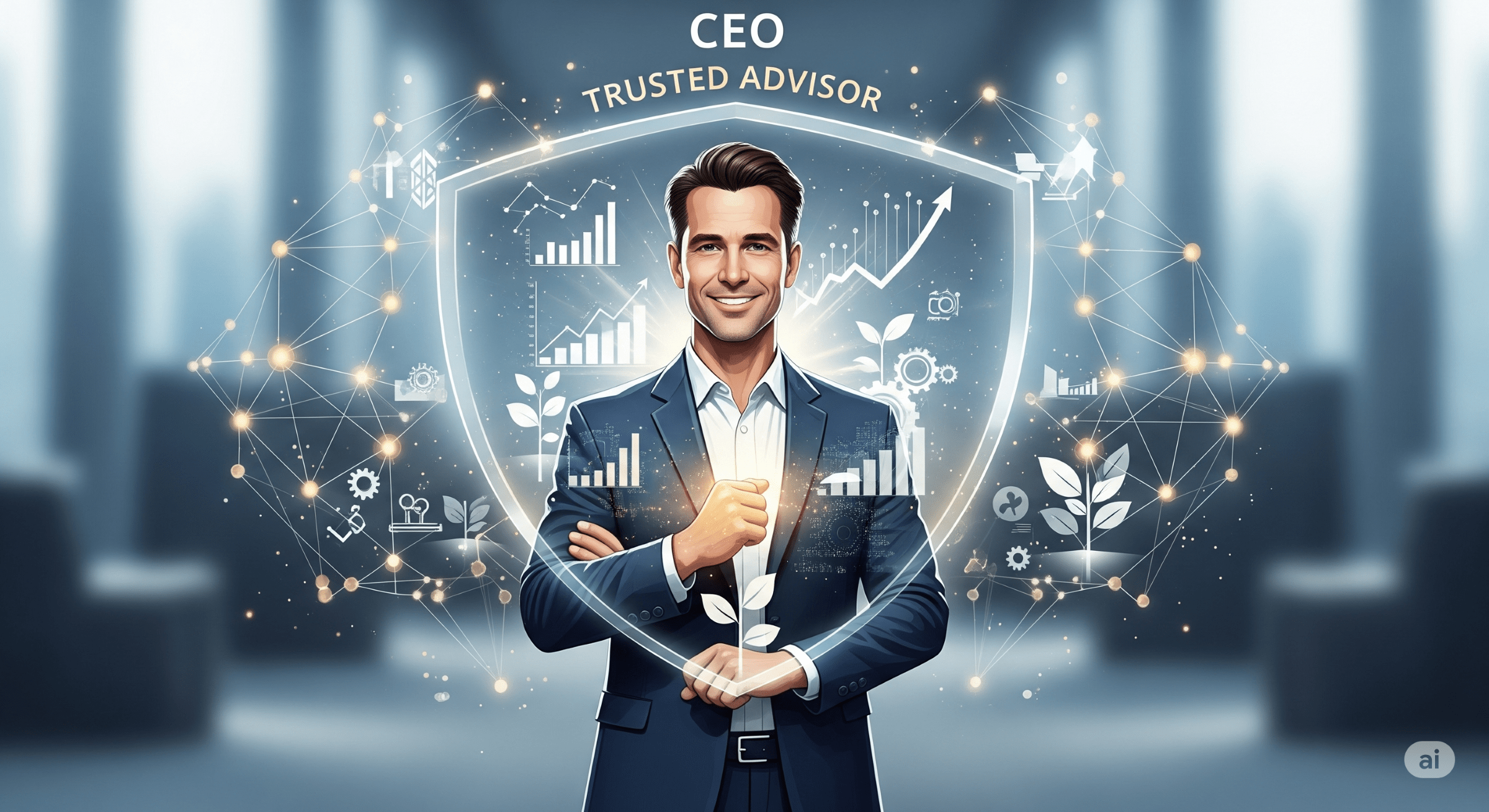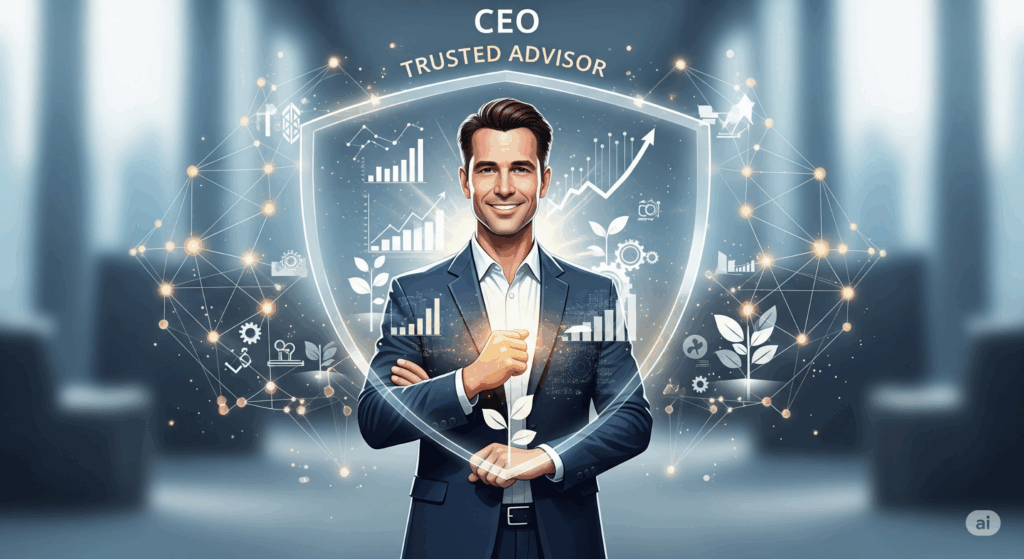This post is also available in:
As a CEO or founder, your time is your most finite and valuable asset. It’s a currency you spend with extreme prejudice on mission-critical tasks: strategy, operations, finance, and team leadership.
Yet, you’re facing a new, persistent demand. Your marketing team keeps asking you to be more “visible.” They want you to post more on LinkedIn, engage in industry conversations, and become the “face of the brand.” You hired them to generate leads, not to give you homework.
This is the modern CEO’s dilemma: a conflict between the operational need to run the business internally and the market’s demand for a visible, authoritative leader externally.
If you’ve felt this tension, you are not alone. It stems from a seismic shift in how high-value B2B decisions are made. The era of the faceless corporation commanding trust through its logo alone is over. For high-ticket, high-trust decisions—the kind that define your company’s future—your clients aren’t buying from a logo. They are buying from a person.
This article will resolve the dilemma. We will prove that investing in your personal brand is not a distraction from your core duties; it is the single most powerful and defensible marketing asset you can build. Furthermore, we will provide a scalable framework for building that brand without sacrificing your schedule, turning your expertise into your most effective client acquisition engine.
The End of the Faceless Corporation: Trust is the New Currency
In the past, B2B marketing was a game of scale and reach. The company with the biggest trade show booth, the glossiest brochure, and the most extensive ad campaign often won. Trust was institutional.
Today, trust is personal. In a world saturated with generic corporate content and AI-generated marketing messages, sophisticated buyers crave authenticity and genuine expertise. Before making a six or seven-figure investment in a service partner, they embark on a journey of digital due diligence.
They don’t just look at your company’s website; they look at you. They scrutinize your LinkedIn profile, read your posts, and watch your interviews. They are asking themselves:
- Does this leader truly understand my problem?
- Are they a genuine expert, or just a good salesperson?
- Do they have a vision for the future of my industry?
- Do I trust their judgment?
Your personal brand provides the answers to these questions long before your sales team ever gets on a call. A strong brand builds trust, collapses sales cycles, and allows you to command premium pricing. A weak or non-existent brand forces your team to start every conversation from zero, perpetually fighting for credibility.
The “Trusted Advisor”: Reimagining the CEO’s Role in Marketing
To build a brand that attracts high-value clients, you must consciously adopt a specific persona. Marketing expert Russell Brunson calls this the “Attractive Character,” a figure who guides customers on their journey []. For the C-suite, this character isn’t the charismatic “influencer” but the respected “Trusted Advisor.”
The Trusted Advisor doesn’t operate like a traditional marketer.
- They don’t pitch; they diagnose.
- They don’t sell; they solve.
- They don’t create content; they share expertise.
This persona is perfectly aligned with the new era of AI-powered search. When a potential client uses Google’s AI Overview or asks a chatbot, “Who is the best expert for solving [X problem] in the [Y industry]?”, the AI scours the web for signals of E-E-A-T (Experience, Expertise, Authoritativeness, and Trustworthiness). A CEO with a robust, visible personal brand as a Trusted Advisor becomes the definitive source, creating a competitive moat that is nearly impossible for competitors to replicate.
The CEO’s Content Operating System: A Scalable Framework
The biggest objection to building a personal brand is always, “I don’t have the time.” This is a valid concern. The solution is not to work harder; it’s to work smarter by installing a system that efficiently extracts and distributes your knowledge.
The Core Principle: “Document, Don’t Create.”
You don’t need to stare at a blank page, trying to “create” content. Your daily work is already a content goldmine. The strategic decisions you make, the client problems you solve, the insights you gain from conversations—this is the raw material. The key is to “document” this expertise.
The Scalable Mechanism: The 30-Minute Weekly Download
Solve the time dilemma by delegating the production of content, not the thinking.
- Schedule a recurring 30-minute meeting each week with a marketer, writer, or skilled assistant.
- Come prepared with one core idea. It could be an answer to a client question from that week, a take on a recent industry trend, or a lesson from a business challenge.
- Talk for 20-25 minutes. Simply explain your idea as if you were talking to a colleague. The person on the other end should record the call and ask clarifying questions.
- Delegate the rest. Your designated “translator” then takes this raw audio/video and turns it into multiple content assets:
- One or two LinkedIn posts.
- A short email for your newsletter.
- A series of tweets or short-form video scripts.
- Potentially a section for a longer monthly blog article.
This system requires only 30 minutes of your focused time per week but generates a consistent stream of authentic content rooted in your unique expertise.
The 3 Stories Every CEO Must Tell
Your content shouldn’t just be a collection of tips. To truly connect with your audience, you need to wrap your expertise in compelling narratives. According to Russell Brunson, stories are what create “epiphany bridges,” allowing your audience to internalize your message and believe in your solution [].
There are three foundational stories every CEO should master.
1. Your “Epiphany Bridge” Story (The “Why”)
This is your origin story. It explains why you are so passionate about solving this specific problem. It’s not about your resume; it’s about the journey and the “aha!” moment that led you to create your company or your unique methodology.
- Structure:
- The Backstory: What was your life/career like before the epiphany? What was the struggle?
- The Wall: What was the specific problem you hit that the old way of doing things couldn’t solve?
- The Epiphany: What was the new discovery or “aha!” moment that gave you the solution?
- The Framework: How did you distill that solution into a framework or system that you can now use to help others? []
This story builds a deep, human connection and establishes the credibility of your unique approach.
2. Your Client’s “Hero’s Journey” Story (The “Proof”)
This is your case study, reframed as a compelling narrative. Your client is the hero, not you. You are the guide who gives them the plan and the tools to succeed.
- Structure:
- The Setup: Introduce your client (the hero) and the high-stakes problem they were facing.
- The Conflict: What challenges did they encounter trying to solve it on their own?
- The Guide Appears: How did they find you? []What was the one “big domino” belief you had to instill in them? []
- The Transformation: What was the plan you gave them, and what were the tangible results they achieved?
- The Resolution: What does their business and life look like now, having achieved this success?
[]This story provides powerful social proof and allows potential clients to see themselves in your successful customers. []
3. Your “Future-Based Cause” Story (The “Vision”)
This is your leadership manifesto. It’s where you share your vision for the future of your industry and invite your audience to be a part of it. []This is how you build a movement, not just a customer base[].
- Structure:
- Identify the Enemy: What is the old, outdated idea, technology, or business model you are fighting against?
- Paint the Picture of the Future: What does the new, better world look like? Why is it a better place for your clients?
- Issue a Call to Arms: Invite your audience to join you in creating this future. This fosters a shared identity and builds a tribe of loyal followers who believe what you believe.
Putting It All Together: Your LinkedIn Presence as a Strategic Asset
By combining the Trusted Advisor persona with a scalable Content Operating System and powerful Storytelling, your LinkedIn presence transforms.
- Your profile becomes a high-conversion landing page.
- Your content, delivered via the Hook-Story-Offer framework, becomes a value-driven magnet for your ideal clients [].
- Your network, built on the Dream 100 strategy of connecting with key players, becomes a powerful distribution channel [].
This integrated approach doesn’t just generate “leads.” It generates a pipeline of high-value prospects who are pre-framed, pre-qualified, and pre-disposed to trust you before the first sales call is ever made.
Conclusion: The Dilemma Resolved
The CEO’s dilemma is real, but it is based on a false premise: that building a personal brand is a time-consuming marketing chore.
When viewed correctly, it is a core leadership function. It is the act of scaling your vision, your expertise, and your trustworthiness to the entire market. It is the most effective way to build a protective moat around your business that no competitor can easily cross.
You don’t need to become a full-time content creator. You simply need to become the Chief Evangelist for your company’s mission. By implementing a system to efficiently share your unique insights and stories, you solve the dilemma. You invest a small amount of your time to create an asset that provides an outsized, compounding return, attracting the very clients you need to drive your business forward.
So, what is the biggest obstacle holding you back from building your personal brand on LinkedIn? Share your thoughts in the comments below.

